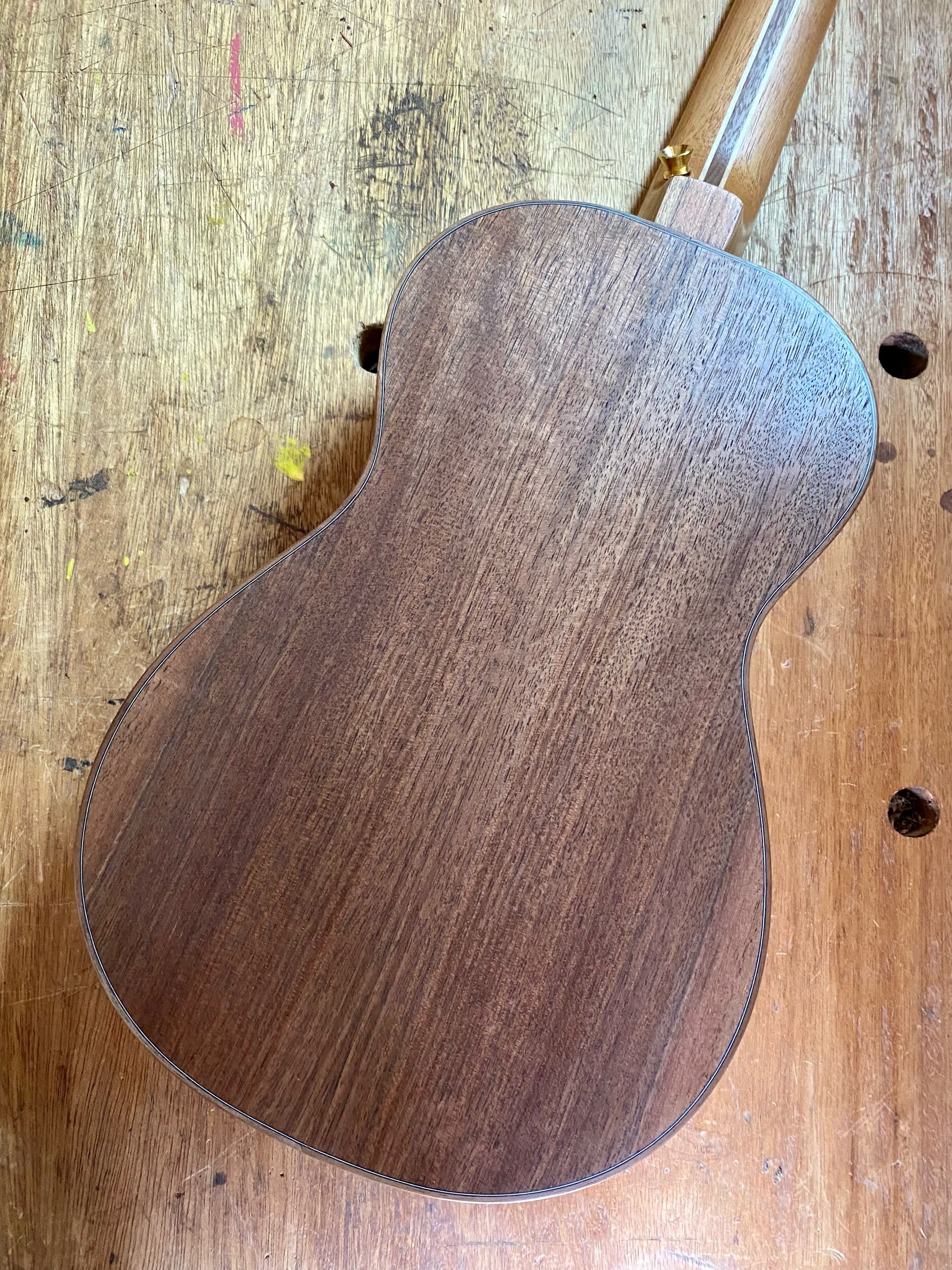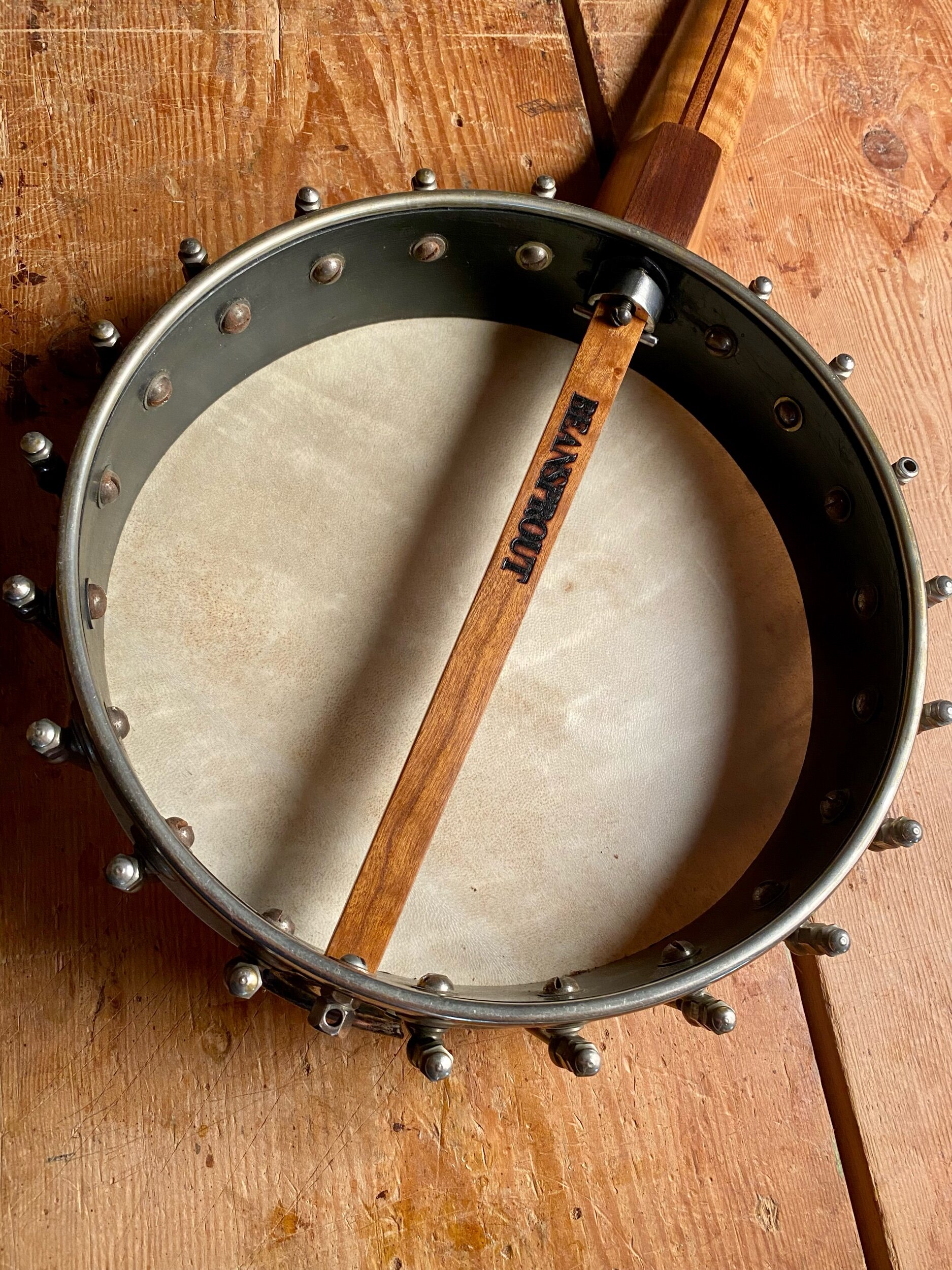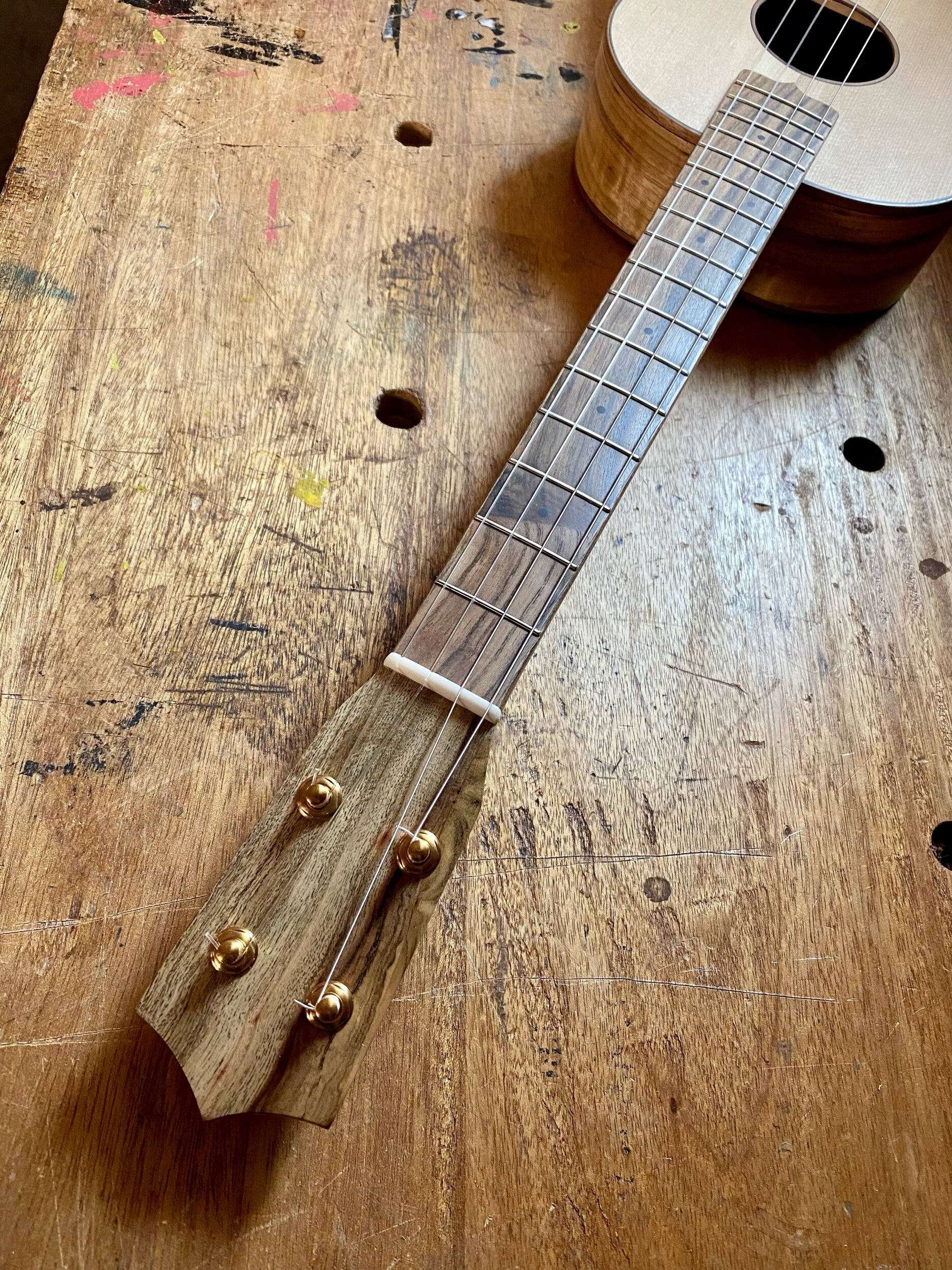This instrument is for our friend and collaborator, Ryan Kolberg. He wanted a second baritone ukulele with a different look and sound, so we chose this curly Myrtle and he let me loose to design the rest. I have been interested lately in the colors and shades blending together a bit by removing the black veneers and purfling that often separate layers on my instruments. Here the Cedar, Walnut and Myrtle flowing together in a Wabi-Sabi reverie. I also took a risk and broke up the book matched panels so that the grain flows around the instrument instead of with a more common rising match. I like it. The Myrtle is from the Oregon Coast via woodfromthewest.com, the Cedar neck is barn salvage by me and the Walnut is from Goby in Portland.
#627- Myrtle Scout Ukulele
I am trying to work through the Scout waiting list. Really, I am. Thanks for your patience, but I also need to sleep. 😜 This one is made from some Myrtle scraps for top/back/sides, Douglas Fir neck and Maple everything else, all from the Carpenter Ant stash in Portland. It has a pickup and is strung low g, which I think is a first for a Scout. It is rustic, beautiful, easy to play and feather light. Happy trails, little Scout.
#626- Western Red Cedar and Quilted Koa Alto Ukulele
It has been fun lately to build these smaller sizes, known for sparkly brightness, and choose woods that sound rich and dark. It makes for a nice balance and a nice playing experience, certainly worth exploring. The Cedar for this build comes from a burned out snag in Washington, the quilted Koa is from Char when she retired from Mya-Moe, the mahogany neck is a scrap from a furniture maker and the Texas Ebony is from a retired banjo builder.
“Thanks for making such a beautiful ukulele. The craftsmanship is incredible and the combination of woods, shades of color, grain patterns, and timbre makes for a truly unique instrument that is even more amazing than what I imagined. I’ve played it almost every day since I received it and the sound just keeps getting better. It is a joy to play. Bravo!
Best Regards,
M. H. ”
#631- Curly Red Oak and Walnut Tenor Banjo Ukulele
As much as I like the fancy ones, my taste often runs to the simple. In this case, the combo of curly red oak, walnut and brass. It was a treat to build and a treat to play! The oak and walnut are from The Carpenter Ant stash and are the scraps left from building a book shelf for my son. The elegant hardware is from Brooks Masten.
#630- Curly Maple and Texas Ebony Five String Banjo
I am a slow, heavy ship, which naturally turns slowly. I say “no” to many of the ideas and requests my customers have, because I take a long time to learn new skills and longer still to find a way to incorporate them seamlessly into my process. I also have a sharp urge to keep the ordering process and the aesthetics of the instruments simple, so I really don’t want too many options. In this case, Brian really wanted to bind the fretboard and headstock with rope binding. I finally said yes. It’s not perfect, but it’s honest and it looks cool. Let me do it 100 more times and I’ll be closer to getting it totally right.
Curly maple from the closing sale at Wildwood Banjos, Texas Ebony from Brown Banjos upon his retirement. Tasty darkened brass hardware from Brooks Masten and stained goat skin.
#617- Port Orford Cedar and Walnut Tenor Ukulele
When I got the call to make a pair of ukuleles for Dave Mathews, I called Ryan right away. He is a big fan and he asked for one just like Dave. He already had two build slots purchased, so the timing worked out well. I milled matching wood for four instruments and got to work. It turned out Dave needed three, so the fourth was Ryan’s. The one piece Port Orford Cedar top is from a leftover board from Mya-Moe. The Walnut is from up the road, The Dee Mill. The pistachio is from California Orchards and the mahogany is salvaged from a furniture maker.
#619- Hemlock and Dogwood Scout Ukulele
Made from scraps and cutoffs from the Carpenter Ant stash in Portland. The back and sides are Dogwood, from a tree onsite that Ken milled, dried and saved. The top is hemlock, the neck is fir and the fretboard/headplate are cherry.
#622- Curly Port Orford Cedar and Mastergrade Walnut Baritone Ukulele
Over time, this has sort of become a standard model. Curly Port Orford Cedar and Mastergrade Walnut back and sides with a crazy Pistachio fretboard. Sounds big, looks amazing and super fun to play. The top is from the Oregon cost and the grafted Walnut and Pistachio are from California orchards, all via woodfromthewest.com. The Spanish Cedar neck is from a stash of timber I bought from a retired builder.
“Hi, I want you to know that my Uke arrived safely and completely! It’s just beautiful! I’m looking out over the Pacific as I get to know her.
I have to tell you that this Uke is perfectly intoned. Usually, even my high quality Ukes need some tweaking by the Doc. But, this one is on the tones at each playable fret!
The craftsmanship is stunning, you certainly built something that will be in the family for ever.
Normally, I’d be playing something different but, after tuning this one up, I felt …almost…commanded to play
Make you feel my love by Dylan.
To each of you, my customer experience was great, my Uke is great and I hope you make millions of dollars and thousands of friends!!
Peace and Love,
- T. B. ”
#621- Wine Barrel White Oak, Pistachio and Walnut Tenor Banjo Ukulele
This instrument was ordered by Charley, a winemaker from Napa Valley with a company called March Wines. (Try the Rose!) https://www.marchwines.com I thought it would be a great opportunity to finally use the wine barrel scraps I’ve been scavenging from the winery up the road from me, https://hiyuwinefarm.com. (Try the Arco Iris!)
Wine barrels are commonly made from White Oak, which is one of my favorite woods. It makes a banjo that is loud and crisp, with an old time, dusty sound that I love. I used Pistachio from California orchards for the fretboard and headplate and some Oregon walnut trim to tie it all together. I made the tension hoop myself, inspired by Pete Ross’ riveted hoops. The other brass hardware is by my friend Brooks Masten in Portland.
#623- Mahogany Alto Ukulele
On one hand, this instrument has a traditional vibe: Mahogany body and neck, rope binding and dark fretboard. But on the other hand, it has some more modern features: wider neck, Walnut radiused fretboard, (instead of a tropical wood), geared tuners and a low fourth string. Overall, it turned out rich and sweet, easy to play and comfortable to hold. It’s off to our old friend Tony in Minnesota, happy strumming!
The Mahogany and the Walnut were salvaged from scraps from the Carpenter Ant Stash in Portland.
“I have played my Beansprout Alto a great deal since receiving it. Yes, the construction quality is a 10 out of 10. Same with the wood, the finishing and the sound. I have learned to expect nothing but the finest of all these from Beansprout. My tenor Beansprout Myrtle is the same. One of the things that is superb, but hard to describe is the feel when I am playing my Alto. It is almost an absence of feel. My Alto, which I have named Eliza after the song Little Liza Jane, sort of disappears while I am playing it. It’s like it does and sounds the way I want without me really thinking about it. It just fits perfectly and is there in my arms doing the absolute right things. I don’t know if I am describing it adequately. I do know that after owning Mya Moe, Martin, Kamaka, KoAloha and other top brands, Eliza is something special. Thank you!
- T. A.
”
#618- Douglas Fir and Pistachio Tenor Ukulele
This instrument is a tribute to everything flawed, scarred, twisted, grafted, wrinkled, salvaged or cast aside. It’s a celebration of sustainability, art, real emotions and honest work. It’s for an artist named Todd Fink, which will make perfect sense when you go to his website and check out his TED talk below.
The back, sides, headplate, fretboard and bridge are made from grafted, scarred and tractor blight Pistachio, salvaged from California orchards by woodfromthewest.com. The Douglas Fir neck and top are salvaged from the garage at the Carpenter Ant stash in Portland. The rope binding stitches it all together, unifying the two woods from California and Oregon.
It has some songs inside, I can’t wait for Todd to find them.
#620- Port Orford Cedar and Curly Walnut Tenor Ukulele
Sustainable woods, natural aesthetic, muted color palette, easy playability and a big voice. This one is a great illustration of my hard work, the things I care about and the community that surrounds our business. Thanks for giving me the chance to do this everyday and thanks for paying attention.
Port Orford Cedar top, Curly Walnut back and sides, Pistachio fretboard/headplate/bridge and Myrtle binding from woodfromthewest.com. Douglas Fir neck salvaged from a floor joist.
#616- Spruce and Curly Walnut Alto Ukulele
This is a second alto ukulele for Jann, who asked for one with a low fourth string and good playability all the way up the neck. She has been tackling some challenging classical music lately and needs the extra range. I had fun with contrasts on this one, with the light spruce, dark walnut and greenish pistachio all wrapped up in maple binding. It’s loud but rich and sings all the way up the neck, I hope it works for her.
The spruce top is from Camp Westwind on the Oregon coast, the curly walnut was a gift from guitar maker Ben Bonham, the fir neck is salvaged from a floor board and the Pistachio is from California orchards.
#624- Curly Cherry and Texas Ebony Five String Banjo
This was a fun challenge for me and it turned out great! The rim is a 10” spunover rim from the late 1800’s that I got from eBay. I thought it would be a could partner for a short scale (20”) neck. I used a neck blank made from curly cherry and Texas ebony, which I got from a retired builder. I think it makes for a classic look that still suits my style. I chose a goat skin head and non steel strings tuned to open g. It’s lightweight, smaller than a regular banjo, easy to play and makes great use of an old banjo rim.
“Hi Aaron,
It’s already a few weeks ago that #624 arrived safely at my home and I would like to thank you for this unique banjo. It looks beautiful and it’s a pleasure to explore its tonal universe, dynamized by the “vivid” goat skin. In addition it offers the baritone uke like size that I had dreamed of to take it with me on vacations.
All the best,
- M. W. ”
#603- Port Orford Cedar and Walnut Tenor Ukulele
A third instrument for Dave Matthews, this time with the stop stained rustic dark and extra big fret dots for onstage visibility. Port Orford Cedar from the Oregon coast, Oregon Walnut from the Dee Mill, Pistachio from California orchards and salvaged Honduras Mahogany.
#615- Hemlock and Walnut Scout Ukulele
The Scout ukulele is my version of the famous Lyon and Healy camp ukulele from the 1920’s. I make them from shop scraps and offer them up to a wait list. They are soprano scale, with geared tuners, bone nut and saddle and strap buttons. Humble, fun and easy to play. All the wood for this one is from the Carpenter Ant stash in Portland. Hemlock top, walnut back, sides, fretboard, headplate and bridge, fir neck. Happy strumming!
#611- Spruce and Mastergrade Myrtle Baritone Ukulele
Wow. This one is just sweet. Very balanced with all the highs, mids and lows. Also, it’s the right mix of fancy and rustic that really speaks to me. The Sitka spruce top is salvaged from a dulcimer maker, cut in the 1960’s. The Myrtle is from guitar maker Jayson Bowerman. The Pistachio is from California Orchards. The Douglas Fir neck is salvaged from a floor joist.
#612- Curly Maple and Pistachio Tenor Banjo Ukulele
Check out that maple! I pulled this board from the Carpenter Ant Stash for my kitchen cabinets, but decided it was too nice for that. Maple is the traditional tone wood for banjos and this is a good example of why. Rich, loud and sweet at the same time. The pistachio is from California orchards and is a perfect secondary wood to the curly maple.
“Hi Nicole and Aaron,
I’m loving the Banjo uke! It’s the absolute best of both worlds for me, banjo sound without having to learn a new instrument. That said, I’m busy trying to reimagine some of the tunes I play with Banjo type fills. I am enjoyed how it has both a nice, long sustain and also a percussive attack. How is it possible to have both? Good intonation all the way up, and it looks gorgeous. I really like the curly maple. I also bought a new amp to plug in to (fishman loudbox charge), and this thing is a cannon played through the amp.
Thanks again!
- N. O. ”
#610- Spruce and Curly Maple Tenor Ukulele
Spruce and maple just has “it.” Loud, sweet, lots of sustain, a big dynamic range, rich overtones and it looks nice too. Keep asking for it and I’ll keep making it. The curly maple and pistachio are from woodfromthewest.com, the Sitka spruce is from my dulcimer maker’s stash and the Douglas fir neck is salvaged from Portland floor boards.
“The uke sounds amazing and I love the look of it. I appreciate the time and care that went into the workmanship.
Thanks,
E. C. ”
#613- Mesquite and Pistachio Mini Five String Banjo
The mini five string banjo is one of our original Beansprout designs from our re-launch 5 years ago and it still holds up. This one is tuned to open c tuning, like a capo on the fifth fret of a regular banjo. But, it can also be quickly tuned to cgcea which is more comfortable for Ukulele people. The combination of mesquite, pistachio, brass and goat skin is rustic but fancy and it rings like a bell. The pistachio is from California Orchards and the mesquite is from a retired banjo builder.
































































































































